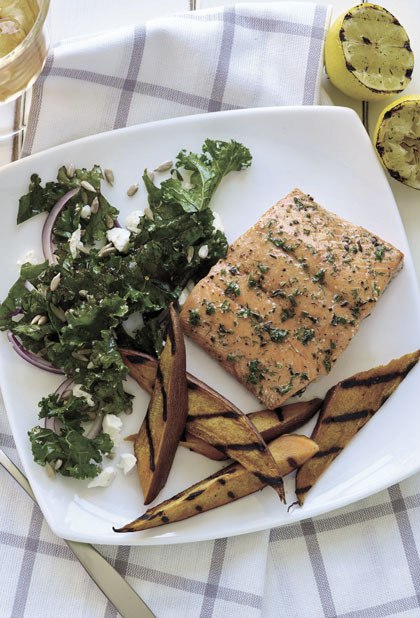Family Features
Whether you’re a competitive sprinter chasing a new record or an everyday gym hound looking to get the most from your workout, seafood is among the best foods to support an athletic lifestyle. It not only delivers great-tasting nutrition, but also provides one-of-a-kind health benefits.
The combination of lean protein, anti-inflammatory omega-3s and muscle-building nutrients are found in Alaska seafood.
Find more recipes and nutritional values for your favorite seafood at wildalaskaseafood.com
Cedar Plank Grilled Salmon with Sweet Potatoes
Serves: 4
Prep time: 10 minutes
Cook time: 15 minutes
Cedar planks with enough surface area for salmon
4 Alaska salmon fillets (4-6 ounces each), fresh, thawed or frozen
Olive oil spray
1 tablespoon fresh (or 1 teaspoon dried) dill, thyme or rosemary
Salt and freshly cracked pepper, to taste
4 large sweet potatoes, sliced lengthwise into wedges
1/2 tablespoon ground cumin
Soak cedar planks for 1-2 hours (or overnight) submerged in water. Remove and pat dry.
Heat grill to medium heat (400 F). If frozen, rinse ice from salmon under cold water; pat dry with paper towel. Spray cedar planks and salmon with olive oil spray. Place salmon on planks; sprinkle with herb, salt and pepper. Place sweet potatoes in bowl; spray with cooking spray. Sprinkle with cumin and salt and pepper, to taste. Toss to coat.
Place cedar planks and potato wedges on grill. Cover and cook about 3-4 minutes; turn wedges over and continue cooking until potatoes are soft and cooked. Keep warm. Cook salmon 12-15 minutes, until fish is opaque throughout.
Nutritional information per serving: 350 calories; 11 g total fat; 2 g saturated fat; 27% calories from fat; 91 mg cholesterol; 33 g protein; 33 g carbohydrate; 4 g fiber; 277 mg sodium; 36 mg calcium; 1,700 mg omega-3 fatty acids.
Miso Halibut with Soba Noodle Stir-Fry
Serves: 4
Prep time: 15 minutes
Cook time: 15 minutes
1 package (12 ounces) prepared soba noodles (or noodle of choice)
4 Alaska halibut fillets (4-6 ounces each), fresh, thawed or frozen
3 tablespoons sesame oil, divided
2 cups roughly chopped bok choy
1 1/2 cups sugar snap peas
1 cup sliced mushrooms
1/2 cup chopped green onions
1/4 cup miso
1 cup water
1/4 cup teriyaki sauce
Prepare noodles according to package directions; set aside.
If frozen, rinse ice glaze from halibut under cold water; pat dry with paper towel. Heat large, nonstick skillet or wok over medium-high heat. Brush both sides of halibut with half of the sesame oil.
In heated skillet, cook fish, uncovered, about 3-4 minutes, until browned.
Shake pan occasionally to keep fish from stick-ing. Turn halibut over; reduce heat to medium and cover. Cook 5-7 minutes for frozen halibut or 2-3 minutes for fresh/thawed fish, cooking until fish is opaque throughout.
Transfer fillets to plate; cover to keep warm.
Wipe out skillet/wok with paper towel. Add remaining sesame oil. Heat to medium-high then add and stir-fry bok choy, snap peas, mush-rooms and green onions. Stir in noodles; turn off heat. Cover and keep warm.
In saucepan, blend miso, water and teriyaki sauce. Bring mixture to boil then reduce heat to a simmer and cook 1 minute. Stir sauce into warm noodle-vegetable mixture. To serve, divide and portion mixture into 4 bowls or plates. Top each with halibut fillet.
Nutrition information per serving:
571 calories; 15 g total fat; 2 g saturated fat; 22% calories from fat; 56 mg cholesterol; 38 g protein; 71 g carbohydrate; 7 g fiber; 1,643 mg sodium; 77 mg calcium; 219 IU vitamin D; 350 mg omega-3 fatty acids.


